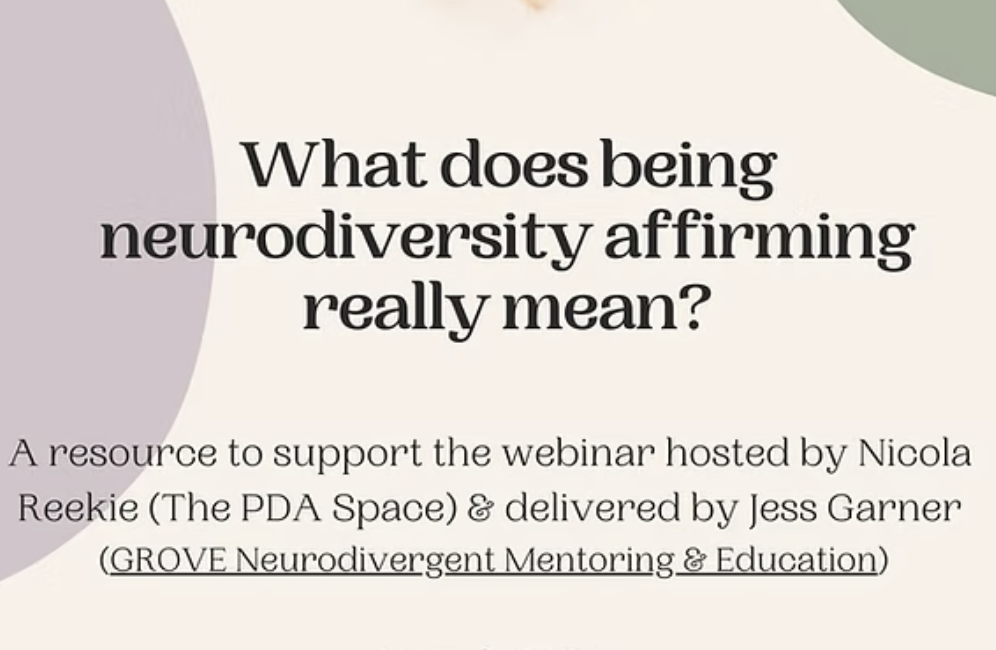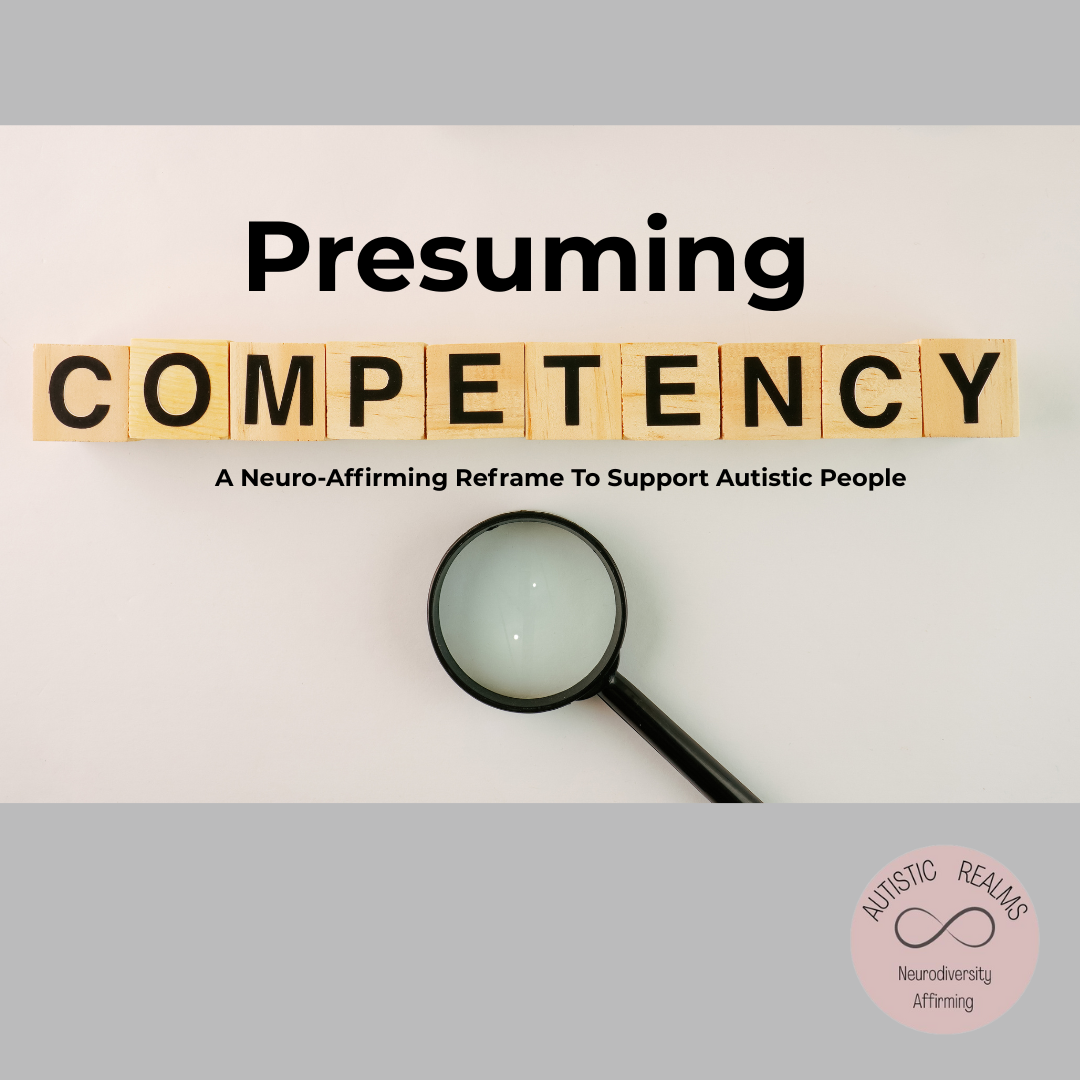Your basket is currently empty!

Protecting the Meaning of Neuro-Affirming Practice
The word neuro-affirming was born from our community — from Autistic, ADHD, and otherwise neurodivergent people demanding change and a right to live as our authentic neurodivergent selves. It emerged as a rejection of behaviourism, pathology, and neuronormativity. It calls for practice grounded in understanding, connection, and dignity rather than control or compliance.
As Nick Walker (2021) reminds us, the neurodiversity paradigm is not about celebrating difference in a superficial way — it’s about fundamentally rejecting the pathology paradigm. To be neuro-affirming is to resist the idea that there is a single correct way to think, feel, or communicate. It’s an ethical stance, not a therapeutic technique.
Yet the term neuro-affirming is increasingly being attached to the very systems it was created to move beyond. Clinics now advertise “neuro-affirming ABA” or “neuro-affirming behaviour support,” language that sounds progressive but conceals dangerous practices rooted in control and compliance. This trend is not harmless. It misleads those seeking safe, affirming care and risks erasing the hard-won progress our community has built over decades.
As Chapman (2022) observes, behaviourism operates within broader systems of oppression — neoliberalism, ableism, and what he terms neurotypical hegemony — where conformity is rewarded and divergence is pathologised. To attach the word neuro-affirming to such systems is to strip it of integrity and reduce a radical movement for autonomy and justice to a marketing slogan.
When professionals borrow the langauge of the neurodiversity movement without changing the systems of control behind it, the result is confusion and harm. Behaviourism and neuro-affirmative care are fundamentally incompatible — one is about compliance, the other about connection.
Kieran Rose explained all of this very eloquently and powerfully in their blog last week The Danger of Misunderstanding Neuro-Affirming Practice (Oct, 2025) if you want a deeper dive!
What Neuroaffirming Practice Really Means
Behaviourism is based on the belief that human behaviour can and should be observed, measured, and modified to meet the expectations to fit into society a certain way. It assumes that certain ways of communicating, moving, or relating are preferable, usually those that align with neurotypical expectations and the dominant social norm.
Behaviourism is neuro-conformist NOT neuro-affirming.
To describe ABA, PBS, or any behaviourist approach as neuro-affirming is an oxymoron. You cannot affirm someone’s neurotype while intervening and trying to make them appear less Autistic or less neurodivergent. The two frameworks rest on opposite values: behaviourism seeks control, while neuro-affirmative practice seeks understanding and connection.
As Kieran Rose pointed out in their recent blog, ‘The Danger of Misunderstanding Neuro-Affirming Practice (Oct 2025);
“There’s been a lot of debate lately about whether “neuro-affirming” practice is just another form of brain determinism.It isn’t.
The real problem isn’t the Neurodiversity Paradigm, it’s Neurodiversity-Lite: the watered-down, performative version that borrows the language of affirmation but strips it of meaning. It pathologises, reduces people to “brains,” and in doing so, ends up reproducing the very harm it claims to resist.
True neuro-affirming practice rejects determinism. It centres lived experience, identity, agency, and the messy realities of human lives. It isn’t about boxing people in, it’s about creating conditions where they can thrive as themselves while also challenging the systems that punish difference.”
Rose, K. (2025) The Danger of Misunderstanding Neuro-Affirming Practice
Neuro-affirmative practice begins from a radically different foundation in that Autistic and neurodivergent ways of being are already valid. As Dundon (2024) writes, neurodiversity-affirming practice “acknowledges that all brain types, including those that are different to what society considers the norm, are equal in value and valid in their right to exist.”
This means valuing strengths, accommodating challenges, and respecting differences in communication, learning, and behaviour. Dundon (2024) outlines Seven Guiding Principles of Neurodiversity-Affirming Practice:
- Tailor support to individual needs.
- Presume competence.
- Promote autonomy.
- Respect all communication styles.
- Be informed by neurodivergent voices.
- Take a strengths-based approach.
- Honour neurodivergent culture.
Protecting the Heart of the Neurodiversity Movement
The neurodiversity movement has always been about self-definition, collective care, and systemic change. We need neuro-affirmative practice that centres neurodivergent perspectives, rejects deficit-based models, and values autonomy, interdependence, and lived experience.
Behaviourism, by design, relies on external control. Neuro-affirmative practice, by contrast, is grounded in relational trust. To combine them under one label — as in the alarming trend of “neuro-affirming ABA” — empties the word neuro-affirming of its meaning. It is not evolution; it is appropriation. It is deeply harmful and painfully misguiding for those families trying to navigate the mass of misinformation out there to gain support for themselves or loved ones.
A great guide for authentic neuro-affirmative practice is embodied in Thriving Autistic’s “Commitment to Neuro-Affirmative Practice” (Neurodivergent Practitioners Directory, 2025), which outlines what genuine, ethical neuro-affirmative practice looks like and was inspired by the Therapist Neurodiversity Collective International.
I am honoured to work with Thriving Autistic as this commitment shows what neuro-affirmative work looks like in practice, not through neurodiversity-lite slogans, but through everyday ethics and accountability.
• We presume competence
• We offer alternative & augmentative communication methods
• We advocate for self-determination
• We advocate for inclusion
• We facilitate self-advocacy skills
• We do not support ABA practice or any methodologies that teach compliance
• We take a strengths-based approach
• We respect each client’s autonomy
• We respectfully appreciate intersectionality in both ourselves and our clients & work to unpack any privilege we may have
• We are actively anti-racist
• We are LGBTQIA+ affirmative
• We actively seek out Continual Professional Development (CPD), research and learnings from other neurodivergent adults
• We use identity-first language while respecting individual clients’ preferences
Thriving Autistic (Neurodivergent Practitioners Directory), (2025). Commitment to Neuro-Affirmative Practice. https://neurodivergentpractitioners.org/about-verified-practitioners/
Beyond “Neurodiversity-Lite”
In recent years, the words neurodiversity and neuro-affirming are popping up everywhere. Infinity symbols seem to be decorating therapists websites, clinic walls and educational spaces. At first, this visibility looks like progress, it is as though the world is finally listening to us, but unfortunately, this is sometimes surface-level and tokenistic.
Neurodiversity-lite describes a surface-level, performative use of neurodiversity, using language and phrases like “different, not less” without the deeper commitments to disability justice, systemic change, and lived experience that define the neurodiversity paradigm.
The neurodiversity paradigm is not just a set of nice words, it’s a political and cultural framework rooted in disability rights, the human rights movement and the social model of disability. It recognises neurological differences as part of human biodiversity, calling for societies to adapt rather than expecting individuals to “overcome” their neurology and be “fixed” or “treated”. It demands accessible environments, autonomy, and an end to ableist structures.
Neurodiversity Lite, by contrast, adopts this vocabulary but discards the politics. It swaps liberation for awareness and swaps systemic reform for inspirational slogans, and grassroots leadership for token representation. This diluted framing can appear affirming while reinforcing control over Autistic, neurodivergent and disabled people’s bodies, choices, and our narratives.
“Neurodiversity-lite” happens when people use our language and symbols without changing their practice. It’s when organisations call themselves “neuro-affirming” while still relying on behaviourist frameworks. It’s when services rebrand with the infinity symbol but maintain the same systems of control beneath it.
This kind of tokenism turns inclusion into performance, a way to look progressive without real change. Using the infinity symbol and things like identity-first language whilst still enforcing neuro-conformity sends a confusing message to people and leaves people doubting who they can really trust.
Keeping Neuro-Affirming Practice Authentic and Community-Led
As I wrote earlier this year in my piece about the harm of neurodiver sity-lite; neuro-affirming practice “is not a toolkit or checklist — it’s a paradigm shift.”
True neuro-affirmative practice means shifting the power imbalance, making systemic changes, listening to the lived experience of neurodivergent people, and letting go of methods that prioritise compliance over wellbeing.
Our language and symbols carry deep meaning. They were created within our communities to represent pride, connection, and resistance to the systems that try to “normalise” or “fix” us. When systems adopt our language and symbols without our values, they hollow it out.
To keep neuro-affirming practice authentic, it must remain community-led and be accountable to the Autistic and neurodivergent people who shaped it, not to the institutions that once (and still do) pathologise us.
| Neurodiversity-Lite | Neurodiversity-Affirming Practice | Key References |
|---|---|---|
| Marketable, apolitical branding | Grounded in disability justice & rights frameworks | Walker (2021); Chapman (2020) |
| Controlled by institutions; professionals and those in power set the agenda | Led by neurodivergent and disabled communities | Botha (2020); Milton (2012) |
| Token awareness days & slogans and using language of neurodiversity without action | Structural change, accessibility, and autonomy | Walker (2021); Doherty, McCowan & Shaw (2023); Kapp (2020) |
| Individual “inspiration” stories | Collective belonging, care, and interdependence | hooks (1999); Kapp (2020) |
| Maintains neuronormative domination | Challenges systemic ableism & oppression | Botha & Gillespie-Lynch (2022); Walker (2021) |
| Isolated from wider struggles and lived experience | Intersectional solidarity with justice movements | Botha (2020); Botha & Gillespie-Lynch (2022); Walker (2021); Crenshaw (1991); Yergeau (2017) |
Neuro-Affirming Practice: From Behaviour Control to Human Connection
Neuro-affirming practice is about creating safety so that authenticity can emerge. It values co-regulation over coercion, curiosity over correction, and connection over compliance.
When we replace control with understanding, we move from managing behaviour to meeting needs. When we shift from compliance to compassion, we make space for growth that honours both autonomy and interdependence.
True neuro-affirmative practice lives in our relationships, in the moments of trust, listening, and mutual adjustment, co-regulation, shared flow and accommodating differences. It cannot coexist with systems that treat behaviour as pathology or authenticity as defiance.
Finally…….
Protecting the meaning of neuro-affirming practice means drawing clear, compassionate boundaries. Neuro-affirming practice cannot grow in spaces rooted in compliance, coercion, or control. It cannot be defined by those who have not lived its necessity or felt what it means to be unseen, unheard, or misread by the systems meant to help.
True neuro-affirmative practice and care is not a technique or a trend; it is a relational ethic. It begins in the quiet shift that happens when we stop trying to make people fit systems and instead reshape systems to fit people.
It’s about cultivating environments where difference is not merely tolerated but centred , where every way of thinking, feeling, and being is recognised as part of the shared human story rather than a deviation from it.
Neuro-affirming practice isn’t a trend, it’s a human rights commitment.
Neuro-affirmative practice rejects behaviourism, control, and compliance, it is rooted in the neurodiversity paradigm.
To affirm neurodivergence is to reshape systems, not people.
Neuro-affirmative practice places dignity, autonomy, and justice at the core of care. These are non-negotiable foundations, grounded in human rights and disability rights principles.
Let’s protect the meaning of being neuro-affirming — not as a tokenistic label to display, but as a living, ongoing commitment to dignity, authenticity, and genuine inclusive practice.
FREE EBOOK:
What does neurodiversity-affirming really mean?
Download the FREE E-BOOK in my shop.
What does neurodiversity-affirming really mean?
Created based on the webinar by Jess Garner from GROVE for The PDA Space.
Inside, you’ll find:
✨ A plain-language introduction to the neurodiversity paradigm and movement
✨ Why behaviourist approaches can harm neurodivergent people
✨ How to spot “neurodiversity-lite” and performative inclusion
✨ Practical ways to be neuro-affirming in education, parenting, and services
✨ Key concepts, language guidance, and red flags to watch for
✨ Links to further reading and community resources
This is more than just a language guide, it’s a call to shift mindsets, challenge deficit-based models, and create environments where neurodivergent people can thrive.
Download for free and take the first step toward truly neuro-affirming practice.

References & Further Reading
Behaviourism and Neuro-Affirming Practice: A Clash of Paradigms
ABA/PBS and Behaviourism can never be trauma-informed or neurodiversity affirming
Chapman, R. (2022). Empire of Normality: Neurodiversity and Capitalism. Pluto Press
Dundon, R. (2024, February). Breaking down the basics of neurodiversity-affirming practice. JKP Blog. https://blog.jkp.com/2024/02/neurodiversity-affirming-practice/
Edgar, H., & Adkin, T. (2025, August 11). Embracing neurodiversity affirmative practice: A path to inclusive support for autistic people. National Autistic Society. https://www.autism.org.uk/advice-and-guidance/professional-practice/embracing-neurodiversity-affirmative-practice
Edgar, H. (Autistic Realms), (2025). Authentic neurodiversity affirming practice matters. https://autisticrealms.com/authentic-neurodiversity-affirming-practice-matters/
Edgar, H. (Autistic Realms), (2025). Neuro-affirming language glossaries. https://autisticrealms.com/neuro-affirming-language-glossaries/
Edgar, H. (Autistic Realms), (2024). Top 5 neurodivergent informed strategies. https://autisticrealms.com/top-5-neurodivergent-informed-strategies/
Edgar, H. (Autistic Realms). (2025). Beyond “Neurodiversity-Lite”: Why Neurodiversity-Affirming Practice Matters. https://autisticrealms.com/authentic-neurodiversity-affirming-practice-matters/
Rose, K. (2025, October). The danger of misunderstanding neuro-affirming practice. The Autistic Advocate. https://theautisticadvocate.com/the-danger-of-misunderstanding-neuro-affirming-practice/
Stimpunks. (2025). Neuroaffirming. https://stimpunks.org/glossary/neuroaffirming/
Therapist Neurodiversity Collective. https://therapistndc.org/
Thriving Autistic (Neurodivergent Practitioners Directory). (2025). Commitment to neuro-affirmative practice. https://neurodivergentpractitioners.org/about-verified-practitioners/
Walker, N. (2021). Neuroqueer Heresies: Notes on the Neurodiversity Paradigm, Autistic Empowerment, and Postnormal Possibilities. Autonomous Press.
Neurodiversity-Affirmative Autism Assessments
Hartman, D., Kavanagh, M., Azevedo, J., O’Donnell-Killen, T., Doyle, J., Day, A., & Day. (2023). The Adult Autism Assessment Handbook: A Neurodiversity Affirmative Approach. Jessica Kingsley Publishers.
Kavanagh, M., Day, A., Hartman, D., O’Donnell-Killen, T., & Doyle, J. K. (2025). The Neurodiversity Affirmative Child Autism Assessment Handbook. Jessica Kingsley Publishers.
Seeking A Supportive Neuro-Affirming Practitioner?
Check out: Thriving Autistics’ Directory of Neurodivergent Neuro-Affirming Practitioners.
Read more:
Latest Posts
-
Autistic Burnout – Supporting Young People At Home & School

Autistic burnout in young people is real—and recovery starts with understanding. This post offers neuroaffirming ways to spot the signs, reduce demands, and truly support. 💛 #AutisticBurnout #Neuroaffirming #Monotropism #AutisticSupport
-
Monotropic Interests and Looping Thoughts

The theory of monotropism was developed by Murray, Lawson and Lesser in their article, Attention, monotropism and the diagnostic criteria for autism (2005). Monotropism is increasingly considered to be the underlying principle behind autism and is becoming more widely recognised, especially within autistic and neurodivergent communities. Fergus Murray, in their article Me and Monotropism:…
-
Map of Monotropic Experiences

Monotropism seeks to explain Autism in terms of attention distribution and interests. OSF Preprints | Development and Validation of a Novel Self-Report Measure of Monotropism in Autistic and Non-Autistic People: The Monotropism Questionnaire This map highlights 20 common aspects of my personal monotropic experiences. How many do you experience? Where are you on the map…
-
Autistic Burnout – Supporting Young People At Home & School

Being autistic is not an illness or a disorder in itself, but being autistic can have an impact on a person’s mental and physical health. This is due to the often unmet needs of living in a world that is generally designed for the well-being of people who are not autistic. In addition, three-quarters of…
-
The Double Empathy Problem is DEEP

“The growing cracks in the thin veneer of our “civilised” economic and social operating model are impossible to ignore”, Jorn Bettin (2021). The double empathy problem (Milton, 2012) creates a gap of disconnect experienced between people due to misunderstood shared lived experiences. It is “a breakdown in reciprocity and mutual understanding that can happen between people…
-
Top 5 Neurodivergent-Informed Strategies

Top 5 Neurodivergent-Informed Strategies By Helen Edgar, Autistic Realms, June 2024. 1. Be Kind Take time to listen and be with people in meaningful ways to help bridge the Double Empathy Problem (Milton, 2012). Be embodied and listen not only to people’s words but also to their bodies and sensory systems. Be responsive to people’s…
-
Autistic Community: Connections and Becoming

Everyone seeks connection in some way or another. Connections may look different for autistic people. In line with the motto from Anna Freud’s National Autism Trainer Programme (Acceptance, Belonging and Connection), creating a sense of acceptance and belonging is likely to be more meaningful for autistic people than putting pressure on them to try and…
-
Monotropism, Autism & OCD

This blog has been inspired by Dr Jeremy Shuman’s (PsyD) presentation, ‘Neurodiversity-Affirming OCD Care‘ (August 2023), available here. Exploring similarities and differences between Autistic and OCD monotropic flow states. Can attention tunnels freeze, and thoughts get stuck? Autism research is shifting; many people are moving away from the medical deficit model and seeing the value…
-
Monotropism Questionnaire & Inner Autistic/ADHD Experiences

Post first published 28th July 2023 Over the past few weeks, there has been a sudden surge of interest in the Monotropism Questionnaire (MQ), pre-print released in June 2023 in the research paper ‘Development and Validation of a Novel Self-Report Measure of Monotropism in Autistic and Non-Autistic People: The Monotropism Questionnaire.‘ by Garau, V., Murray,…
-
Penguin Pebbling: An Autistic Love Language

Penguin Pebbling is a neurodivergent way of showing you care, like sharing a meme or twig or pretty stone to say “I’m thinking of you,” inspired by penguins who gift pebbles to those they care about.
-
Presuming Competence: A Neuro-Affirming Reframe To Support Autistic People

When “presume competence” is applied without a neuro-affirming lens, it can become a harmful, ableist expectation
-
Ethics & Values of Autistic Realms

Autistic Realms is grounded in values of authenticity, autonomy, and relational care for the human rights of Autistic or otherwise neurodivergent and disabled people. These guiding principles align closely with the ethics and principles of both the Therapist Neurodiversity Collective (TNDC) and the Autistic Self Advocacy Network (which I am a member of – ASAN),…
-
Inclusion Needs Recognition, Not Erasure: A Neurodiversity-Affirming Approach

When headlines claim that autism and ADHD are “invented labels,” it’s more than rhetoric, it’s erasure. A explores why removing neurodiversity from education would harm the very children inclusion is meant to protect.













